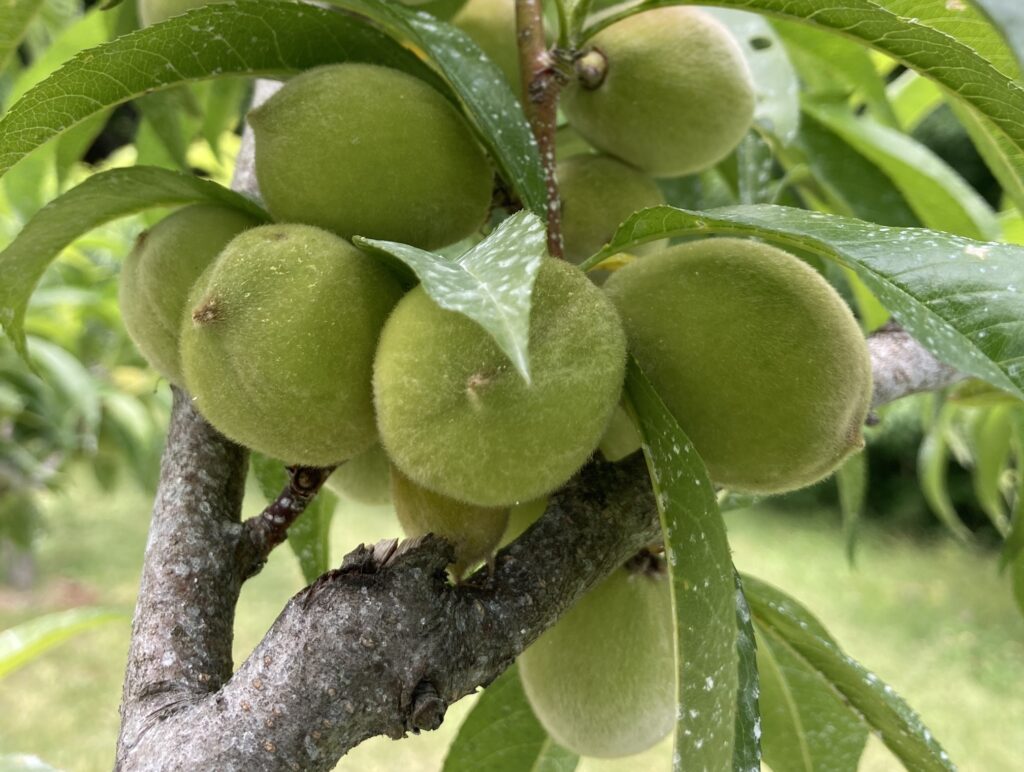A cluster of peaches before the thinning to one every 3 inches. (Courtesy of Paul Doscher)
“Yikes! What are you DOING?” my friend nearly screamed at me. She had asked me to come by the home where she was house sitting and take a look at a couple of peach trees that obviously needed pruning. I had taken a saw and clippers to the tree and at that moment had probably cut off 90 percent of the growth from the previous year. She was shocked.
I’ve been growing peaches at our farm in Weare for 43 years. When I started, I knew little about fruit trees and depended for the first couple of years on the good advice provided by our local UNH Cooperative Extension fruit specialist. When it came to learning about pruning fruit trees, my neighbor who had been a professional tree pruner was my mentor.
Paul Doscher prunes a peach tree in Weare. (Courtesy of Paul Doscher)
Peaches, in those days, were an iffy crop. Winter temperature extremes could kill off the flower buds that grew the previous summer nearly one in three years. Even more extreme weather could occasionally even kill a peach tree. Our climate in those days was on the “marginal” end for peaches, a species that preferred a bit warmer winter and less extreme low temperatures. But in the past couple of decades it’s become possible to expect a crop almost every year.
When the trees are doing well, it’s necessary to be brutally aggressive with pruning if you want a good crop of peaches. My friend witnessed that brutality on those couple of trees and thought I was killing them.
Under favorable conditions, peaches will produce a phenomenal number of flowers and each one wants to become a peach. Without pruning, a mature tree can produce thousands of tiny fruit. But if you want to harvest those juicy 3-inch fruit in July and August, you need to give each peach room to grow. And cutting back the stems with dozens of flowers, before they start to grow in spring, is the first step in making that happen.
Step two, which is done in mid- to late June, is “thinning” rapidly forming little peaches. Just this week I’ve been doing that on our four peach trees, and it’s not a quick job. After about two hours of work on two trees I filled a pair of 5-gallon buckets with little green peaches a bit smaller than golf balls. Left on the tree, about 3 inches apart, were a few hundred green fruit that will hopefully create a bountiful crop in late July and August.
It’s a job that never happened last summer. Thanks to a severe cold snap in February 2023, almost the entire Northeast peach crop was killed, including mine. Later in the spring, a late heavy frost wiped out much of the apple crop. If there had been peaches on the trees, no doubt they would have been obliterated as well.
But 2024 is very different. Our erratic new climate gave us an exceptionally warm winter and every peach flower bud on every tree seems to have survived. No peach tree can hold a thousand peaches without branches breaking, so every tree needed heavy pruning and then serious thinning. Those backyard peach trees that didn’t get this attention will produce lots of tiny peaches, and lots of broken branches that can’t hold the weight of the crop.
A bucket of thinned peaches from just one peach tree. (Courtesy of Paul Doscher)
So, this is the year of the peach. I don’t know how our local commercial growers handle the thinning process, but I’ve seen that they too prune aggressively. They will have a good crop this season, barring a mid-summer hail storm that bruises the fruit.
If you like peaches and don’t grow them yourself, go to a local orchard and buy fresh-picked. The peaches in the supermarket cannot compare to the local fresh varieties. Why? Because peaches grown in the South or California (where most of the nation’s crop is produced) have to be picked before they ripen. Once ripe, and sweet, a peach is too tender to pack in the mechanized operations that grow them on a large scale. Many, if not most, are picked too soon to allow them to continue to ripen once cooled and refrigerated for shipping. They will never develop the extraordinary flavor of a ripe or nearly ripe peach, picked fresh from the tree.
When we have a crop, peaches grace our table nearly every day. We eat them on cereal, mix them in pancakes, and top them on yogurt. We make them into pies. We can them and store them for winter. Do we ever have too many peaches? Oh yes, and that’s when we call the neighbors and plead with them to come pick the peaches we cannot keep up with.
For many years we assumed (sometimes wrongly) that there would be a peach crop every summer. Last year reminded us that a changing climate isn’t just about warmer summers and winters, but extremes in temperature and rainfall.
This year we would be wise to take advantage of the “year of the peach” and can a lot more quarts than we’ve done in the past. The future of our crop is uncertain, so we will make the effort to expect the unexpected and prepare for what comes.
The post After a rough 2023, this is shaping up to be the year of the peach appeared first on New Hampshire Bulletin.

